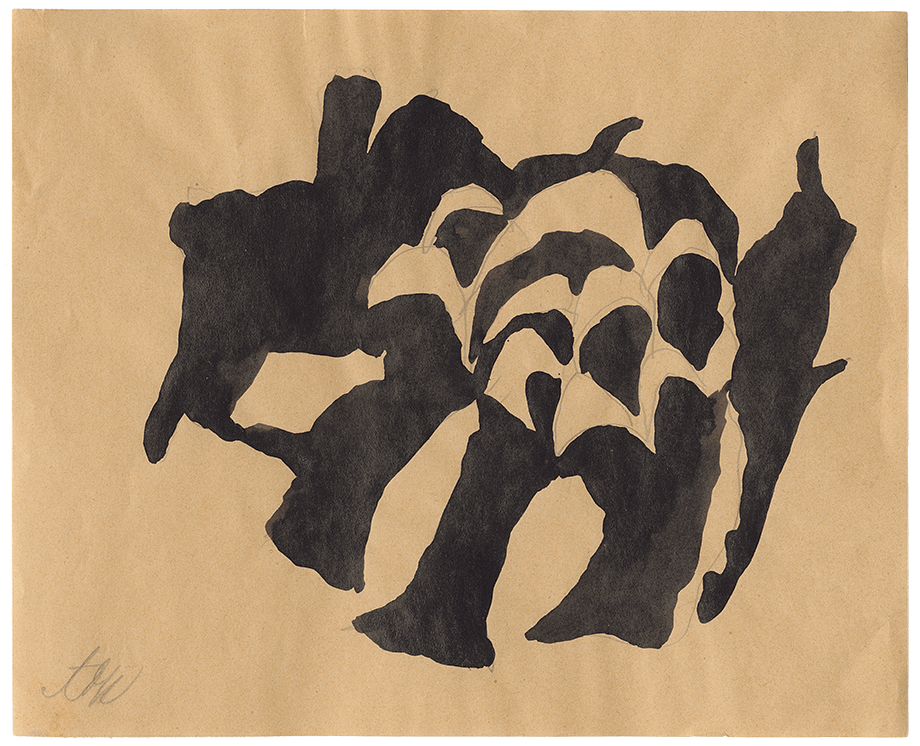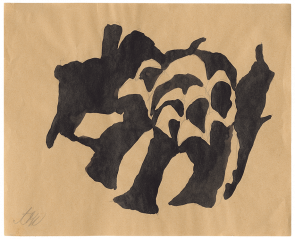After studies in Weimar and Paris and as co-founder of the “Moderner Bund” (Modern Federation), Arp already had considerable experience as an artist and numerous contacts when he came to Zurich in the autumn of 1915. “Disgusted at the carnage of the Great War in 1914, we devoted ourselves to the fine arts in Zurich,” he noted in retrospect in his essay “Dadaland” (1938). He wanted “an elemental art that would cure humans of the madness of the epoch and establish a new order, a balance between heaven and hell.” His art and world-view were in search of transcendence. Even prior to the opening of the Cabaret Voltaire, Arp had found his creative principles and turned away from oil painting and the purely figurative. In November 1915, he showed creations in wool and silk, aside from his Gestaltungen (designs) in ink and charcoal, at the Galerie Tanner. Whether this pre-Dada drawing was one of the ten ink works on exhibit is uncertain. In the entrance area of the Pestalozzi private school, Arp and Otto van Rees created a two-part abstract mural in 1916, a pioneering work of modern art commissioned by the school director and gallerist Han Coray. In his close collaboration with Sophie Taeuber, the geometrical shapes soon gained concrete-constructive clarity, even where he gave free rein to the laws of chance. One inexhaustible source for his creative work to draw on were biomorphic objects with their artificial and yet organic-looking shapes, which he animated, varied, and transformed. The present drawing is already informed by Arp’s biomorphism. The abstract configuration opens up associative spaces into nature. His Dada works on paper from Paris and Cologne, as well as his reliefs and sculptures, speak to Arp’s serene take on nature.
Like Tristan Tzara and Marcel Janco, Arp was one of the Dadaists who were omnipresent in Zurich, and he was the one to make the most important contribution in the field of visual arts. His works were on view in all exhibitions and were regularly reprinted in Dada publications—from Cabaret Voltaire and the periodical Dada to the magazine Der Zeltweg and the illustrated little poetry volumes of the Collection Dada. “Arp’s decorative aspirations,” whose sound foundation Waldemar Jollos appreciatively emphasized in the Neue Zürcher Zeitung, made him ideal as a designer of book or journal covers, particularly when it came to variant and luxury editions. Self-ironically, he commented on his prominent presence in his poetry volume die wolkenpumpe (the cloud pump, 1920):
“ARP is one of the five great dadaist popes / founder of dadaism / original dada / true spiegelgasse dada . . . everybody knows it / every child knows him / every old man greets him respectfully, murmuring oh / there comes the ARP”
Arp was only marginally perceived as a poet at first. His friend Lucian H. Neitzel, dressed up as a dervish and sitting on a carpet, gave the first-ever reading from die wolkenpumpe in March 1917 on the occasion of a costume party thrown by the Laban dancer Mary Wigman. If Arp’s wood reliefs with their allusive titles were called “peinture-poésie,” his painterly poems are “poésie-peinture.” His letters, too, were steeped in “aquadadatinta.” One of them of winter 1921 was about a new joint project in the Collection Dada series and addressed to the “spiritus rector tzar Tristan”; it began with the sender, “dr’ärpl üs schtrosburri,” looking back on Dada Zurich:
“My dear friend, it is with tears in my hollow teeth that I recollect that fruitful poet’s spring, my heart beating wildly when I think of the great Dada, that he should have lived and weaved next to me, the true original, in flesh and blood—hear the shot ringing out which he fired just like that, in his dreams, and which drowned out the roar of the cannons at the siege of Verdun—will mean a central heating to me in this glacier world.”
Provenance: Christian Witzig, Kreuzlingen, 1986.
First exhibitions: New York, Borgenicht Gallery, Arp. Drawings and Collages, arranged by Margarete Schultz, 1962; Munich, Kunsthalle der Hypo-Kulturstiftung, Hanover, Sprengel Museum, Dada. Eine internationale Bewegung 1916–1925, 1993.
→ Richard Huelsenbeck and Hans Arp, Phantastische Gebete [Fantastic Prayers], DADA I:51
→ Cabaret Voltaire, DADA III:37
→ Dada 3, DADA III:33:3
→ Sophie Taeuber and Hans Arp with puppets for König Hirsch [King Stag], DADA VI:1

